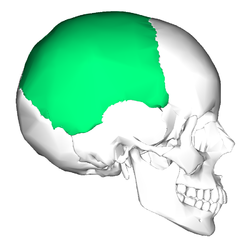Parietal bone
| Parietal bone | |
|---|---|

Human skull showing gun shot trauma on parietal bone
|
|

Position of parietal bone (shown in green)
|
|
| Details | |
| Identifiers | |
| Latin | Os parietale |
| MeSH | A02.835.232.781.651 |
| TA | A02.1.02.001 |
| FMA | 9613 |
|
Anatomical terms of bone
[]
|
|
The parietal bones /pəˈraɪᵻtəl/ are two bones in the human skull which, when joined together at a fibrous joint, form the sides and roof of the cranium. Each bone is roughly quadrilateral in form, and has two surfaces, four borders, and four angles. It is named from the Latin paries (-ietis), wall.
The external surface [Fig. 1] is convex, smooth, and marked near the center by an eminence, the parietal eminence (tuber parietale), which indicates the point where ossification commenced.
Crossing the middle of the bone in an arched direction are two curved lines, the superior and inferior temporal lines; the former gives attachment to the temporal fascia, and the latter indicates the upper limit of the muscular origin of the temporalis.
Above these lines the bone is covered by the galea aponeurotica (epicranial aponeurosis); below them it forms part of the temporal fossa, and affords attachment to the temporalis muscle.
At the back part and close to the upper or sagittal border is the parietal foramen, which transmits a vein to the superior sagittal sinus, and sometimes a small branch of the occipital artery; it is not constantly present, and its size varies considerably.
The internal surface [Fig. 2] is concave; it presents depressions corresponding to the cerebral convolutions, and numerous furrows (grooves) for the ramifications of the middle meningeal artery; the latter run upward and backward from the sphenoidal angle, and from the central and posterior part of the squamous border.
...
Wikipedia
